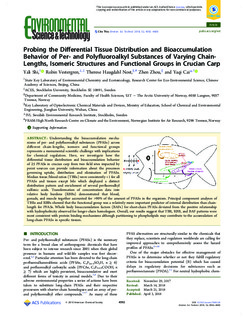| dc.contributor.author | Shi, Yali | |
| dc.contributor.author | Vestergren, Robin | |
| dc.contributor.author | Nøst, Therese Haugdahl | |
| dc.contributor.author | Zhou, Zhen | |
| dc.contributor.author | Cai, Yaqi | |
| dc.date.accessioned | 2018-06-12T09:04:37Z | |
| dc.date.available | 2018-06-12T09:04:37Z | |
| dc.date.created | 2018-06-04T12:55:42Z | |
| dc.date.issued | 2018 | |
| dc.identifier.citation | Environmental Science and Technology. 2018, 52 4592-4600. | nb_NO |
| dc.identifier.issn | 0013-936X | |
| dc.identifier.uri | http://hdl.handle.net/11250/2501237 | |
| dc.description | This is an open access article published under an ACS AuthorChoice License, which permits copying and redistribution of the article or any adaptations for non-commercial purposes: https://pubs.acs.org/page/policy/authorchoice_termsofuse.html | nb_NO |
| dc.description.abstract | Understanding the bioaccumulation mechanisms of per- and polyfluoroalkyl substances (PFASs) across different chain-lengths, isomers and functional groups represents a monumental scientific challenge with implications for chemical regulation. Here, we investigate how the differential tissue distribution and bioaccumulation behavior of 25 PFASs in crucian carp from two field sites impacted by point sources can provide information about the processes governing uptake, distribution and elimination of PFASs. Median tissue/blood ratios (TBRs) were consistently <1 for all PFASs and tissues except bile which displayed a distinct distribution pattern and enrichment of several perfluoroalkyl sulfonic acids. Transformation of concentration data into relative body burdens (RBBs) demonstrated that blood, gonads, and muscle together accounted for >90% of the amount of PFASs in the organism. Principal component analyses of TBRs and RBBs showed that the functional group was a relatively more important predictor of internal distribution than chain-length for PFASs. Whole body bioaccumulation factors (BAFs) for short-chain PFASs deviated from the positive relationship with hydrophobicity observed for longer-chain homologues. Overall, our results suggest that TBR, RBB, and BAF patterns were most consistent with protein binding mechanisms although partitioning to phospholipids may contribute to the accumulation of long-chain PFASs in specific tissues. | |
| dc.language.iso | eng | nb_NO |
| dc.title | Probing the differential tissue distribution and bioaccumulation behavior of per- and polyfluoroalkyl substances of varying chain-lengths, isomeric structures and functional groups in crucian carp | nb_NO |
| dc.title.alternative | Probing the differential tissue distribution and bioaccumulation behavior of per- and polyfluoroalkyl substances of varying chain-lengths, isomeric structures and functional groups in crucian carp | nb_NO |
| dc.type | Journal article | nb_NO |
| dc.type | Peer reviewed | nb_NO |
| dc.description.version | publishedVersion | nb_NO |
| dc.rights.holder | © 2018 American Chemical Society | nb_NO |
| dc.source.pagenumber | 4592-4600 | nb_NO |
| dc.source.volume | 52 | nb_NO |
| dc.source.journal | Environmental Science and Technology | nb_NO |
| dc.identifier.doi | 10.1021/acs.est.7b06128 | |
| dc.identifier.cristin | 1588766 | |
| dc.relation.project | NILU: 111131 | nb_NO |
| cristin.unitcode | 7460,60,0,0 | |
| cristin.unitname | Miljøkjemi | |
| cristin.ispublished | true | |
| cristin.fulltext | original | |
| cristin.qualitycode | 2 | |
